How the vacuum cleaner works: design features and functioning of various types of vacuum cleaners
Understanding how the vacuum cleaner works, its device and the main differences between the different designs of such a technique makes it easier for a potential buyer. Indeed, its quality characteristics, consumer properties and service rules depend on the operating principle and design features of the device.
All these points have been studied by us and are described in detail in the article. The information provided will help to understand the specifics of the functioning of various types of vacuum cleaners, as well as choose the most suitable option among the variety of designs.
The content of the article:
Device and design features
The device unit over the past hundred years has not changed much, as well as its performance. Having walked his way from an electric broom, a hand-driven machine, a pneumatic “renovator” of gas-powered carpets, the vacuum cleaner technically settled on the model of James Spangler.
A cleaner from Ohio made a revolution - created a vertical and portable apparatus from a broom, pillowcase and electric motor. Spangler's invention was marketed under the Hoover brand. A modern device inherits the same design from the electrical part, brush and dust collector.
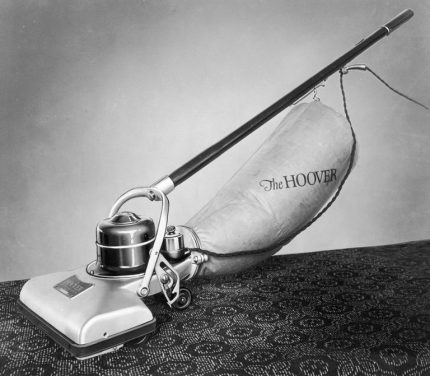
The main components of a conventional vacuum cleaner:
- Centrifugal compressor - creates a vacuum and pumps air.
- Electric motor - drives the compressor.
- Air purifier - separates dust from air, collects it in special containers.
- Set of nozzles and brushes for different purposes.
The body of the device itself is made of durable plastic. An engine, compressor, dust collector, filters, control unit are built inside it.
The standard household design of the vacuum cleaner is equipped with a flexible air hose, extension tube.The exception is small-sized manual models and devices where the compressor is built into the tube with a nozzle or brush.
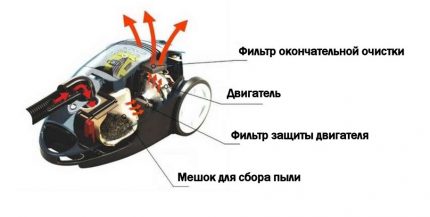
In order to expand the scope of application, manufacturers complete the devices with different nozzles.
Universal is always present in this set. It is intended for cleaning flat horizontal surfaces, carpets. The design includes switches, rollers for maneuverability, brushes with different bristles.

Turbo brushes represent a separate variety, the structure of which allows you to collect wool and hair from carpets. Relatively recently appeared electric brushes, cylindrical rollers, nozzles for parquet, metal debris, cleaning siphons and others.
How do different types of devices work?
All vacuum cleaners perform one function - cleaning. Why are apparatuses invented and manufactured for a single purpose so different from each other in shape, size, principle of operation?
At the first acquaintance with the device, the location of the dust collector, the number of wheels, the material from which the hoses are made, does not seem important. Understanding the significance of every detail comes during operation.
We will analyze the design features and the principle of operation of devices depending on the types of dust collector and the functionality of the devices.
Vacuum cleaner with bag or container
Schematically, the principle of operation of this device can be represented as follows. Through the nozzle and hose, air filled with dust enters the device, namely, into a dust collector - a bag or cyclone filter.
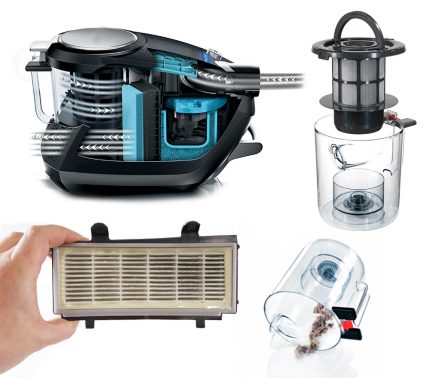
Further, one part of the dirt remains in the tank, the other through the pores and vortex flows of the drive moves towards the motor. To protect it, a coarse filter was invented.
But it is not perfect - dirt travels to the exit and comes to the fine filter (HEPA).
Compact vertical units
A feature of this design in the absence of a hose. It sometimes comes in the kit and can be used to perform individual manipulations. The role of the main dust absorber goes to the brush - turbo or “knocker”.
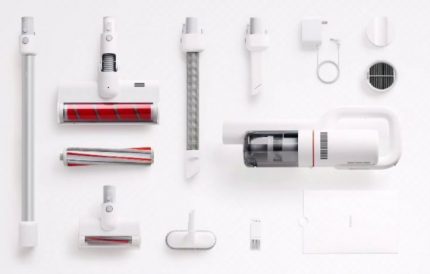
The engine and dust collector in the device are located in the pipe - the unit body. The motor does not so much create a suction force as it rotates the brush shaft. Garbage at the same time as if "swept" in a dust collector.
AT vertical models there is also a suction module. But it is involved in the work when the device is used as horizontal.
Water Filtered Design
In vacuum cleaners with an aquafilter, there is a different way to clean the incoming air, hence the structural features. The device is outwardly similar to the conventional container type of vacuum cleaner - it includes a nozzle and a hose from which debris enters the dust collector-aquafilter.
But the latter is made in the form of a flask with water. The idea of engineers is to trash and dirt drown under the influence of vortex flows.
What creates these threads? Turbine or separator rotating inside the bulb. This visible part of the engine spins dust and creates high pressure. The latter "captures" the particles, regardless of size, immerses them in water and does not give them a chance to get out of there.
In such devices, the shape of the turbine and its rotation speed are important.Manufacturers still have to add filters to insufficiently thought-out designs from the technical side. Approval applies to low cost separator models.
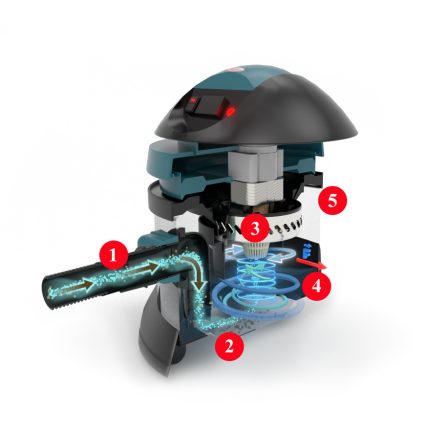
These vacuum cleaners can not be called completely filterless, because a protective filter for the engine is present in them. It was possible to get rid of it only by German engineers who "sewed up" the motor into a capsule made of stainless steel. The motor in this case is reliably closed from dust and wet dirt.
Sophisticated built-in modifications
These devices are not portable and for the most part are mounted inside the walls. Their nozzles and hoses are not connected to the vacuum cleaner body, but are inserted into pneumatic sockets located throughout the zone of the intended operation of the device.
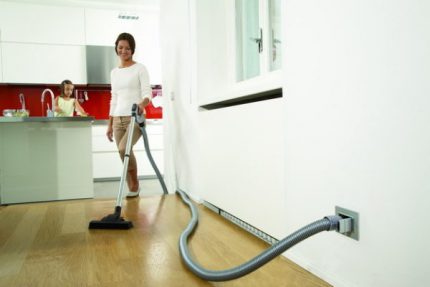
A complex chain of air ducts is arranged in the walls, through which the collected garbage is sent to a common dust collector. The latter is located in the utility rooms or in the basement, if any.
The unit itself includes both the engine and filters. The power plant is also often located in utility rooms.
Features of washing machine models
The main structural difference between washing machines and models with a bag and a container is the presence of a tank for clean and dirty water. Small and large fractions of dirt drown in such a container.
The main advantage of such a tank is that the owner does not have to breathe dust while emptying the tank.
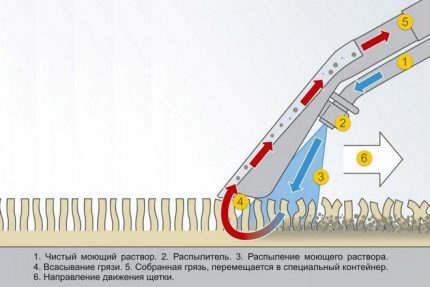
But in construction washing vacuum cleaners protection of the motor from moisture is also provided, which significantly increases the cost of the vacuum cleaner. And on the HEPA filter, moist dirt accumulates, which creates a breeding ground for many bacteria.
There are washing vacuums with a steam generator. This device allows you to clean the surface with steam without the use of chemicals.
High tech robotic vacuum cleaners
Robotic vacuum cleaners appeared only about 10 years ago. Their designs are constantly updated and improved. Devices are created according to the block scheme. This ensures ease of maintenance and ease of replacement of parts during repair.
Common elements of a robot vacuum cleaner, which are in all models:
- side brush;
- block module;
- charging base;
- sensors for detecting obstacles, contamination, elevation.
The operation of such a device is based on a cleaning unit, navigation, driving mechanisms and a battery device.
Gadget navigation systems
The ultra-modern navigation system consists of a laser, a camera, internal and external sensors. The camera reads a map of the room. Rangefinder lasers give her information about the presence of objects in the room, the distances between them.
The device moves in straight lines both during cleaning and in the process of returning to the base.
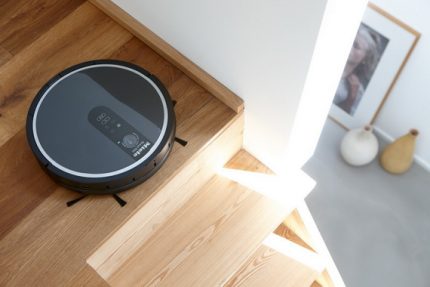
Models are still on sale, the principle of which is based only on sensors. They are located on the inside and inside of the device.
With their help, the robot navigates in space and adjusts its work, as well as notices the most polluted areas and is more careful in cleaning them.
Magnetic tape can also be used in robot navigation. It creates a virtual barrier, beyond which the apparatus does not move. If the cleaner is equipped with a camera, it reads readings from the ceiling and walls.
The cleaning process
Here the models differ in cleaning types - for dry cleaning and washing robots. In the former, the side brush picks up all the dirt and directs it to the central brush. Central has a fleecy surface and is able to collect hair, wool.
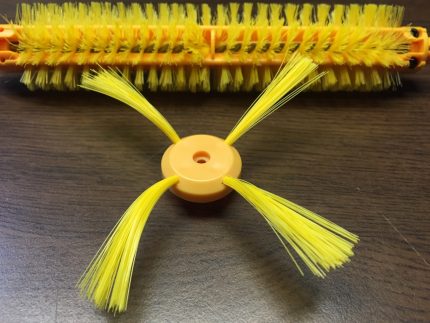
Further, these two parts send garbage to a dust collector, where it is pressed by air currents. And the air passes through the filters out.
Depending on the manufacturer, the design of robots differs in the following nuances:
- Basic brushes. In most models, there are two of them - fleecy and rubber. They work in pairs. Some devices are equipped only with rubber.
- Side brushes. There are devices in which an additional side brush is mounted.
- Filters. Robots are equipped with both standard "napkins" and multi-layer HEPA.
- Container + engine power. The garbage collection tank can have a volume of 0.4 to 1 liter. The power of such devices is 40-65 watts. If the first digits are important during operation, the second ones are insignificant due to the small range.
The main consumer detail of robotic vacuum cleaners is the main brush. It depends on it the quality of cleaning, and not on the engine, as in conventional units.
The wet vacuum cleaner has in its design a system of a water tank and a sprayer. He knows how to collect garbage, spray liquid, rub the floor and collect dirty water back into the tank.
There are robot models designed for mixed cleaning. The principle of their work is to clean smooth surfaces with a rag, and carpet - with main brushes.
Return to base
The final stage of the work of the robot is its return to the mother base. The device is powered by batteries. If they discharge, the device turns off.
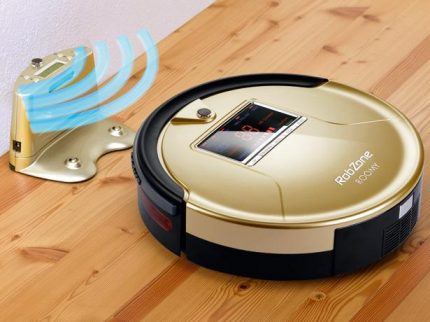
The device independently responds to a low percentage of charge. Using a special sensor, he detects an infrared ray from the base and begins to move towards it. As soon as it finds, it docked with it and charged.
Design details and quality of cleaning
Some design features of the device affect the quality of cleaning and ease of use. For example, a hose. It should be of sufficient diameter (at least 5 cm) so that it often does not clog.
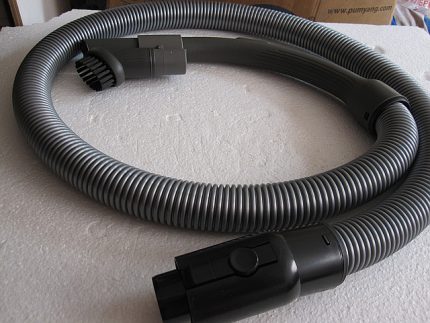
The strength of the material is also important, otherwise the part will crack, which will reduce the suction force.
In addition to the main components, the quality of the device is also influenced by seals, bushings, bearings. If the joints are made of fluoropolymers, this ensures their tightness.
Fluoroplastic and polyamide bushings and bearings extend the life of the moving parts of the device.
For more information about different types of vacuum cleaners, as well as tips on choosing the right unit, see this article.
Conclusions and useful video on the topic
Analysis of the design and principle of operation of the vacuum cleaner with pressure sensors and two electric motors - in the brush and body of the device.
On the examples of several designs of vacuum cleaners it is clearly seen that, regardless of the variety, they all equally serve as "dust cleaners". Their effectiveness depends on the filtration system, engine power, the availability of various nozzles.
And which vacuum cleaner did you choose for your home or apartment? Please tell us why you gave preference to a particular model, whether you are satisfied with the work of the acquired equipment. Add reviews, comments and ask questions - the contact form is below.

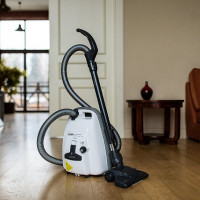 TOP-10 Bork vacuum cleaners: ranking of popular models + brand selection features for brand vacuum cleaners
TOP-10 Bork vacuum cleaners: ranking of popular models + brand selection features for brand vacuum cleaners 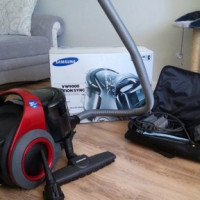 Samsung washing vacuum cleaner overview: brand technology features, advantages and disadvantages + best models
Samsung washing vacuum cleaner overview: brand technology features, advantages and disadvantages + best models 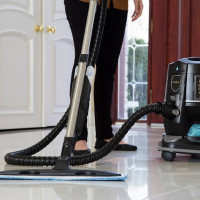 Rating of washing vacuum cleaners for the home + tips for choosing the best model
Rating of washing vacuum cleaners for the home + tips for choosing the best model 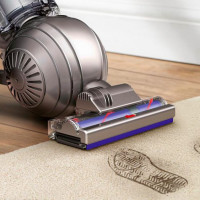 Rating of the best vacuum cleaners from Dyson: an overview of the top ten models in today's market
Rating of the best vacuum cleaners from Dyson: an overview of the top ten models in today's market  Rating of vacuum cleaners for the home 2018-2019: which models are recognized by the best users and sellers
Rating of vacuum cleaners for the home 2018-2019: which models are recognized by the best users and sellers 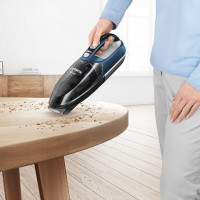 Bosch manual vacuum cleaners rating: TOP-7 models + recommendations for compact equipment buyers
Bosch manual vacuum cleaners rating: TOP-7 models + recommendations for compact equipment buyers  How much does it cost to connect gas to a private house: the price of organizing gas supply
How much does it cost to connect gas to a private house: the price of organizing gas supply  The best washing machines with dryer: model rating and customer tips
The best washing machines with dryer: model rating and customer tips  What is the color temperature of light and the nuances of choosing the temperature of the lamps to suit your needs
What is the color temperature of light and the nuances of choosing the temperature of the lamps to suit your needs  Replacement of a geyser in an apartment: replacement paperwork + basic norms and requirements
Replacement of a geyser in an apartment: replacement paperwork + basic norms and requirements
For many years I was tormented with vacuum cleaners in which garbage was collected in bags. Throwing garbage out of the bag is very difficult, it turns out that the dust scattered around the perimeter near the bucket. Now we have bought a powerful vacuum cleaner with a container, now the cleaning process is very simple and labor costs are minimal. I would like to buy a vertical vacuum cleaner, but it is an order of magnitude more expensive than a conventional wired model.
It is important for me that the vacuum cleaner has high power, because there is a cat with long hair in the house. It is necessary that the vacuum cleaner can clean carpets and furniture as well. It is good that the nozzles are comfortable for furniture: both flat and narrow, so that it is possible to clean the crumbs as well. The cord should be long enough to reach the end of the room.
Vacuum cleaner with water filter, the best choice for home. After cleaning, no shaking, just poured dirty water into the toilet and put the vacuum cleaner in place.
Oh, I wouldn’t say that vacuum cleaners with an aquafilter are all so rosy. For a long time I was tormented with a Thomas washing vacuum cleaner with an aquafilter. The vacuum cleaner is bulky, heavy. Perhaps for you, as a man, this is not a minus, but it was not easy for me to clean. And just pouring water is not enough, as you write. After EVERY cleaning, you need to wash the containers, they dry for a long time, and if you do not dry properly, then they start to stink of some kind of musty. As I recall, I distort.
Now I want to buy some compact and convenient vacuum cleaner with a cyclone. They write that of the significant disadvantages, he has poor harvesting of animal hair, but I do not have them, so this is not a problem.